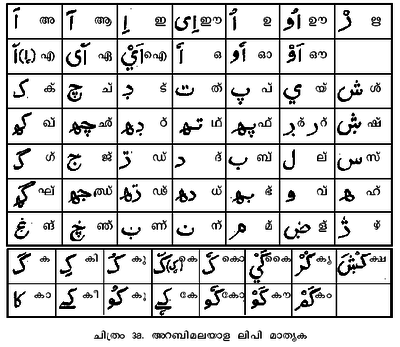Arabi Malayalam
Arabi-Malayalam (Malayalam: അറബി-മലയാളം, Arabi Malayalam: عَرَبِ مَلَیَاۻَمٛ) is a writing system - a variant form of the Arabic script with special orthographic features - for writing Malayalam, a Dravidian language in southern India.[1][2] Though the script originated and developed in Kerala, today it is predominantly used in Malaysia and Singapore by the migrant Muslim community. [3]
| Arabi Malayalam Ponnani Script | |
|---|---|
| Type | |
| Languages | Malayalam |
Time period | c. 500 to the present |
Parent systems | Proto-Sinaitic
|
Until the 20th century, the script was widely taught to all Muslims - including young women - in the primary education madrasahs of Kerala.[4][3] Arabi-Malayalam is currently used in some of the primary education madrasahs of Kerala and Lakshadweep.[5][6]
| Malayalam | Arabi Malayalam | IPA |
|---|---|---|
| ഴ | ژ | ɻ |
| ച | چ | tʃ |
| പ | پ | p |
| ഗ | گ | ɡ |
| [7] | ||

There were many complications to write Malayalam, a Dravidian language, using letters covering Arabic, a Semitic language. Only 28 letters were available from Arabic orthography to render over 53 phonemes of Malayalam. It was overcome by following the pattern of creating additional letters established for Persian.[8] The letters such as pa, gha, kha, ṅa, ña, ḻa, ga, ca were not available in the Arabic alphabets. The characters which stand for ḻa, ca, pa, ga (ഴ, ച, പ, ഗ) are ژ, چ, پ, گ respectively in Arabi Malayalam.
Vowels
അ = اَ
ആ = آ
ഇ = اِ
ഈ = اِي
ഉ = اُ
ഊ = اُو
ഋ = رْ
എ = ا٘
ഏ = ا٘ي
ഐ = اَيْ
ഒ = اٗ
ഓ = اٗو
ഔ = اَوْ
അം = اَمْ
Consonants
ക = ك/ک
ഖ = كھ
ഗ = گ
ഘ = گھ
ങ = ۼ
ച = چ
ഛ = چھ
ജ = ج
ഝ = جھ
ഞ = ڿ
ട = ڊ
ഠ = ڊھ
ഡ = ڗ
ഢ = ڗھ
ണ = ڹ
ത = ت
ഥ = تھ
ദ = د
ധ = دھ
ന = ن
പ = پ
ഫ = پھ/ف
ബ = ب
ഭ = بھ
മ = م
യ = ي
ര = ڔ
ല = ل
വ = و
ശ = ش
ഷ = ۺ
സ = س
ഹ = ھ/ﮭ
ള = ۻ
ഴ = ژ
റ = ر
റ്റ = ڔّ
Most of the Mappila Songs were written, for the first time, in Arabi-Malayalam script. The earliest known such work is the Muhyidheen Mala, written in 1607.[4][3]

Many literary works written in Arabi Malayalam still have not been transliterated to the Malayalam script, and some estimates put the number at almost 90 percent. These works, romantic ballads, folk tales and battle songs, contain some of the impressive literary achievements by Mappilas over the centuries.[1]
The first Arabi Malayalam scripted novel, Chahar Dervesh, Malaylam translation of a Persian work, was published in 1883.[9] Intellectuals such as Moyinkutty Vaidyar translated, and then transliterated significant number of works in Sanskrit - such as Ashtanga Hridaya, Amarakosa, Pancatantra and even the legends about the Hindu king Vikramaditya - into Arabi Malayalam.[10] Sanskrit medical texts - such as Upakarasara, Yogarambha and Mahasara - were also translated, and then transliterated into Arabi-Malayalam by scholars like Abdurahiman Musaliar of Ponnani Putiyakattu.[10] Arabi Malayalam script periodicals made remarkable contributions to the reform movement amongst the Mappilas in the early 20th century. Al-Irshad, published in 1923 by the Muslim Aikya Sangham played an important role in explaining the doctrines of Islam to the common Mappila and distinguishing between what the reformers called religious practices and "superstitions".[11]
See also
- Arwi
- Judeo-Malayalam
- Suriyani Malayalam
- Beary bashe
References
- Miller, Roland. E., "Mappila" in "The Encyclopedia of Islam". Volume VI. E. J. Brill, Leiden. 1987. pp. 458-56.
- Malayalam Resource Centre
- National Virtual Translation Center - Arabic script for malayalam
- Menon. T. Madhava. "A Handbook of Kerala, Volume 2", International School of Dravidian Linguistics, 2002. pp. 491-493.
- "Arabi Malayalam in Lakshadweep". Archived from the original on 2010-10-05. Retrieved 2008-02-22.
- Samastha (Official Website) Archived 2014-09-12 at the Wayback Machine
- Arabi-Malayalam - "E-Malabari"
- Arabi-Malayalam - "E-Malabari"
- Sharafudeen, S. "Muslims of Kerala: a Modern Approach, "Kerala Historical Society, 2003. pp. 152
- "Malayalam Literary Survey", Volume 16 (1) -17 (4), Kēraḷa Sāhitya Akkādami, 1994. pp. 88
- "Journal of Kerala Studies", Volume 17, University of Kerala, 1990. pp. 134
External links
| Wikimedia Commons has media related to Arabi Malayalam. |